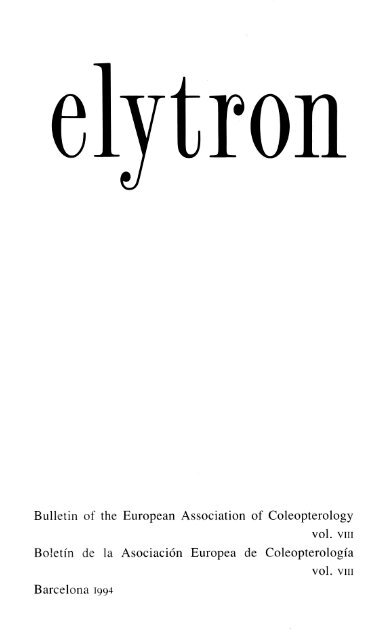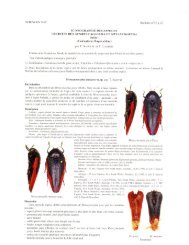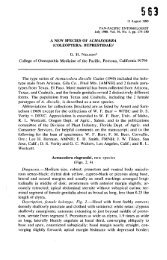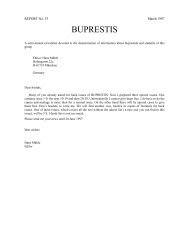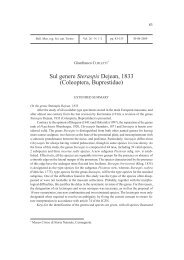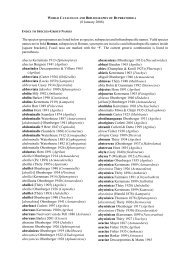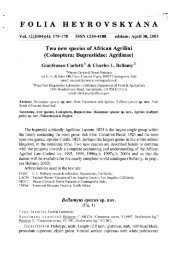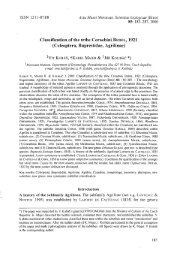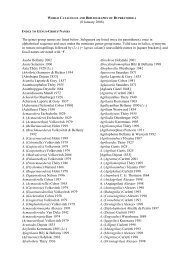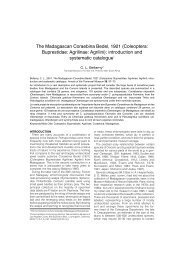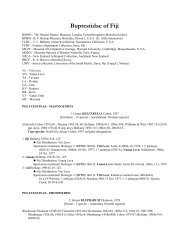Bulletin of the European Association of Coleopterology vol. VIII ...
Bulletin of the European Association of Coleopterology vol. VIII ...
Bulletin of the European Association of Coleopterology vol. VIII ...
You also want an ePaper? Increase the reach of your titles
YUMPU automatically turns print PDFs into web optimized ePapers that Google loves.
<strong>Bulletin</strong> <strong>of</strong> <strong>the</strong> <strong>European</strong> <strong>Association</strong> <strong>of</strong> <strong>Coleopterology</strong><br />
<strong>vol</strong>. <strong>VIII</strong><br />
Boletin de la Asociaci6n Europea de Coleopterologia<br />
<strong>vol</strong>. <strong>VIII</strong><br />
Barcelona 1994
ELYTRON. 1994. Vol 8: 63-72 ISSN: 02 14- 1353<br />
TWO NEW SPECIES OF<br />
MICROACMAEODERA COBOS, 1966 FROM<br />
THAILAND (COLEOPTERA: BUPRESTIDAE)<br />
M. G. Volkovitsh<br />
Zoological Institute<br />
Russian Academy <strong>of</strong> Sciences<br />
199034 ST. PETERSBURG. RUSSIA<br />
C. L. Bellamy<br />
Coleoptera Department<br />
Transvaal Museum<br />
PO Box 413<br />
PRETORIA 0001. SOUTH AFRICA<br />
ABSTRACT<br />
Two New species <strong>of</strong> Microacmaeodera Cobos, 1966 from Thailand (Coleoptera: Ruprestidae).<br />
Mi(./-oc~c~nrucocle~r-u (S~IIUIII~~~I-~U~~III~IC~~~I~~I-~I)<br />
XII/XIIII and M. (Mie~r.ouc.nruco~/c~~c~) tl~uil~~~c/i(~u<br />
spp. n. arc described I'roni Thailand. illuslralcd and contraslcd from thcir congcncrs in both<br />
tabularly and in a kcy.<br />
Key words: Colcoplcra. Uuprcslidac, Acmacodcrinac, Mi[./-otrt~rircrcoclrr-(~, Thailand.<br />
INTRODUCTION<br />
The buprestid genus Mi[*]-oac.n~aeode~-a was originally described by COBOS<br />
( 1966) as a subgenus for Acmaeodel-u (Mic.1-ocic.n~ueode~-a) 1ongic.ol-11i.s Cobos<br />
from eastern Afghanistan. Later <strong>the</strong> status <strong>of</strong> Mic.~-oac.n~ucode~-a was elevated to<br />
<strong>the</strong> generic rank by VOLKOVITSH ( 1986), and two subgenera, Mic.1-oat-n~aeodel-a<br />
(s. .st]-.) and M. (Squarnic.~-oac.n~aeode~-a) were separated.<br />
In terms <strong>of</strong> extant distribution and zoogeography, <strong>the</strong> species <strong>of</strong> Mic.1-oacmacodel-a<br />
arc from <strong>the</strong> Indo-Oriental region: M. (M.) 1ongico1-nis (type species)<br />
and M. (M.) ~7ittn1c.1-i Vol kovitsh are partly geographically sympatric in <strong>the</strong><br />
western Himalayas; M. (S.) helli (Kerremans) (type species) is from India and<br />
M. (S.) a]-ue~~sis ('l'hiry) is from Aru lsland and perhaps Borneo. Recenlly one<br />
more species, M. (S.) rncicg~-ego]-i Bellamy & Volkovitsh ( 1992) was described<br />
from Luzon Is., Philippines.<br />
The discovery <strong>of</strong> two new species, collected by Czech coleopterists in<br />
Thailand during 1991-92, has prompted a return to <strong>the</strong> taxonomy <strong>of</strong> this genus<br />
once again. The locality data is recorded herein as presented on <strong>the</strong> specimen<br />
labels. We are grateful to our colleague Ing. Vitezslav Kuban, Brno, Czech<br />
Republic for rhe loan <strong>of</strong> material for this study; his collection will be<br />
abbreviated VKBC.
M. G. VOLKOVITSH & C. L. BELLAMY<br />
Microacmaeodera (Squamicroacmaeodera) kubani sp. n. (Figs. 1, 2, 6)<br />
Diagnosis<br />
Body small, length 3.4 mm, width 1.2 mm, short, broad, robust, weakly<br />
convex, with marked dorsal curvature (Fig. 1); black with coal-like sheen;<br />
covered with thin white hyaline scales.<br />
Description<br />
Head broad, flat above; front weakly depressed in lower part, with sides<br />
nearly straight and diverging slightly to vertex. Vertex without longitudinal<br />
keel, 1.90~ as wide as transverse diameter <strong>of</strong> eye and 1.06~ as wide as front<br />
above antenna1 depressions. Clypeus narrow, with small, shallow, arcuate<br />
median emargination anteriorly. Front with sculpture reticulate, formed by<br />
rounded superficial umbilicate punctures with marked granules and centrally<br />
placed dots; intervals forming fine transverse rugae in lower part; covered with<br />
short, fine decumbent scales. Antennae short (female), 1.41~ as long as height<br />
<strong>of</strong> eye; expanded from antennomere 5; antennomere 2 ovoid, robust; 3 and 4<br />
similar, short, feebly expanded apically; 5 triangular; 6-10 strongly transverse,<br />
almost 2x as wide as long; I I oblong, irregular. Pronotum evenly convex,<br />
without basal cavities and median depression; slightly wider than long, basal<br />
width 1.41~ length, widest in anterior to base; sides feebly arcuately converging<br />
anteriorly; anterior margin projecting angularly, slightly bisinuate; basal margin<br />
straight. Lateral carina narrow, distinct, entire, straight. Sides with reticulaterugose<br />
sculpture, marked concentric rugae and fragments <strong>of</strong> umbilicate punctures<br />
with distinct dots placed between <strong>the</strong>m; disc with simple punctate sculpture <strong>of</strong><br />
dense large punctures in <strong>the</strong> middle; intervals smaller than diameter <strong>of</strong> punctures,<br />
shining. Vestiture consisting <strong>of</strong> short, barely visible, decumbent, fine scales.<br />
Anterior prothoracic margin slightly bisinuate, bordered by a deep groove;<br />
prothoracic sculpture consisting <strong>of</strong> small, elongate, asperate umbilicate punctures;<br />
sculpture <strong>of</strong> meso-, metathorax and metacoxae consisting <strong>of</strong> similar punctures.<br />
Hypomera with reticulate-rugose sculpture <strong>of</strong> marked longitudinal rugae with<br />
shagreened intervals and hardly visible vestiges <strong>of</strong> umbilicate punctures. Elytra<br />
broad, convex; 2.13~ as long as wide at base; sides slightly converging<br />
posterior to humeri, feebly diverging arcuately toward midpoint, and firstly<br />
evenly arcuate, <strong>the</strong>n strongly, almost straightly converging to widely jointly<br />
rounded, nearly truncate apices. Incisure posterior to humeri shallow but<br />
marked, extending into shallow curvature at <strong>the</strong> level <strong>of</strong> hind coxae; denticles<br />
<strong>of</strong> epipleura small, hardly visible only in apical 114. Stria1 punctures fine,<br />
fusing toge<strong>the</strong>r along <strong>the</strong> entire length <strong>of</strong> elytron and forming grooves on<br />
posterior 113; striae distinct along entire length. Intervals flat, nearly similar,<br />
3-4x as wide as striae; 9th not elevated, without serration; covered with large,<br />
superficial, uniseriate punctures on finely rugulose background, especially on<br />
basal 113, and with evenly uniseriate, narrowly lanceolate, hyaline, short scales<br />
approximately 112 interval width; surface shining, without pattern. Legs black;<br />
metacoxae with posterior margin straight, slight emarginate laterally but without<br />
lateral tooth. Tibiae slightly expanded apically, straight. Femora with thin<br />
scales; tibiae with short inconspicuous setae; metatibiae bearing one row <strong>of</strong><br />
white bristle-like setae on external margin. Tarsomeres nearly similar; 5th thin,<br />
expanded apically; tarsal pulvilli present, well developed on 1-4, each larger<br />
toward distal end; basal tarsomeres with markedly longer setae laterally. Claws<br />
short, broad, curved, and with broad, blunt tooth before middle <strong>of</strong> internal
TWO NEW SPECIES OF MICROACMAEODERA<br />
Figs. I ant1 4: Dol.s;~l habitus <strong>of</strong>: Mic~rocrcn~creodcru (Sq~ron~ic~-oac~ni~~codcrc~) Xuhot~i. sp. n. ( I );<br />
Mic.r.onc~niurur1er.a (s. sir..) thoilandica, sp. n. (4).<br />
margin. Abdomen completely black; with reticulate sculpture, 1st and anal<br />
sternites with reticulate-rugose sculpture with marked longitudinal rugae; disc<br />
with partly obliterated reticulate sculpture <strong>of</strong> elongate umbilicate punctures;<br />
covered with fine decumbent scales. Anal sternite <strong>of</strong> female short, broadly<br />
rounded, feebly deflexed apically.<br />
Male. Unknown.<br />
Female<br />
Ovipositor <strong>of</strong> tubular type (Figs. 2, 6), ra<strong>the</strong>r elongate, approximately 3 .5~<br />
as long as enlarged part; ra<strong>the</strong>r deeply emarginate apically; with short parallelsided<br />
styli, separated from each o<strong>the</strong>r by 2x <strong>the</strong>ir length, bearing apical bristles<br />
1.5~ as long as length <strong>of</strong> stylus. Hemisternites thin, slightly curved; apical<br />
sclerotization <strong>of</strong> dorsal ones poorly marked, undifferentiated, without recurved<br />
branches (Fig. 6).
66 M. G. VOLKOVITSH & C. L. BELLAMY<br />
Specimens examined<br />
Holotype, female: Thailand, Thimonghta, 350m, 15.02N, 98.335E, 9- 13.-<br />
IV.1991, Vit. Kuban Igt.; Thailand '91, Thanon Thong Chai, D. Kral et V.<br />
Kuban. Holotype deposited in VKBC.<br />
Comments<br />
Microacmaeoder-a (S.) kuhani comes closest to M. (S.) aruensis, differing<br />
by <strong>the</strong> small body, lateral keel <strong>of</strong> pronotum entire, and sculpture <strong>of</strong> hypomera<br />
and abdomen markedly reticulate-rugose. From this last character it differs<br />
from all o<strong>the</strong>r species <strong>of</strong> M. (Squamicroacmaeodera). The four species <strong>of</strong> this<br />
taxon are contrasted in Table 1.<br />
Etymology<br />
This new species is obviously named for <strong>the</strong> collector <strong>of</strong> <strong>the</strong> unique type<br />
specimen, our friend and colleague Vita Kuban.<br />
Microacmaeodera (Microacmaeodera) thailandica sp. n. (Figs. 3, 4, 5)<br />
Diagnosis<br />
Body small, length 3.2 mm, width 1.0 mm, elongate, relatively broad,<br />
convex, with poorly marked dorsal curvature (Fig. 4); black with coal sheen;<br />
covered with white hyaline decumbent setae.<br />
Figs. 2 and 5: Ovipositor, dorsal aspect: Microacniaeodera (Squamicroacn~aeoder'a) kuhani, sp. n.<br />
(2); Microacmaeodera (s. str.) thailandii~a, sp. n. (5).
TWO NEW SPECIES OF MICROACMAEODERA<br />
Description<br />
Head broad, convex from above, feebly flattened in middle; front weakly<br />
depressed in middle, convex in dorsal portion, sides nearly straight and<br />
strongly converging to vertex; vertex without longitudinal keel, 2. 10x as wide<br />
as transverse diameter <strong>of</strong> eye and 0.95~ as wide as front above antenna1<br />
depressions. Clypeus very narrow. nearly straight, with weak, broad, arcuate<br />
median emargination anteriorly. Front with sculpture punctate, formed by fine,<br />
simple, sparse (particularly on vertex) punctures; intervals smooth, shining,<br />
wider than diameter <strong>of</strong> punctures; covered with short. fine, decumbent setae.<br />
Antennae relatively short (female). 2 .0~ as long as height <strong>of</strong> eye: expanded<br />
from antennomere 5: antennomere 2 ovoid, robust; 3 and 4 similar, short,<br />
feebly expanded apically; 5- 10 triangular, nearly as wide as long, with arcuate<br />
inner margin; 11 elongate with rounded apex. Pronotum evenly convex,<br />
without basal cavities and median depression; slightly wider than long. basal<br />
width 1.25~ length, widest between middle and posterior 113; sides arcuately,<br />
more strongly converging anteriorly than posteriorly; anterior margin feebly<br />
projecting anteriorly, nearly straight; basal margin straight. Lateral carina<br />
narrow. distinct, entire, nearly straight. reaching anterior margin. Sides with<br />
pseudoalveolate culpture; disc with simple punctate sculpture <strong>of</strong> sparse punctures;<br />
intervals larger than diameter <strong>of</strong> punctures. shining. Vestiture consisting <strong>of</strong><br />
short, decumbent. similar, hyaline setae. Anterior prothoracic margin slightly<br />
bisinuate. bordered by a fine groove; prosternum evenly convex with small,<br />
sparse, deep, simple punctures; sculpture <strong>of</strong> meso-, metathorax and metacoxae<br />
consisting <strong>of</strong> similar, but larger punctures. Hypomera with large, deep, simple<br />
punctures on finely shagreened background. Elytra relatively broad, convex;<br />
2.30~ as long as wide at base; sides slightly converging posterior to humeri,<br />
<strong>the</strong>n very feebly diverging to midway between middle and posterior 113. and<br />
weakly arcuate, converging to widely jointly rounded apices. Incisure posterior<br />
to humeri very shallow but marked; denticles <strong>of</strong> epipleura small, serrate.<br />
visible only in apical 114. Stria1 punctures deep, rounded or slightly elongate,<br />
isolated on anterior 112 and parlly fusing posteriorly; forming shallow grooves<br />
on posterior 112; striae distinct along entire length. Intervals subconvex, nearly<br />
similar, narrow, 1.5-2.5x, at most 3x as wide as striae; 9th not elevated,<br />
without serration; covered with fine, marked, mostly uniseriate punctures on<br />
finely rugulose. shining background, and with short, uniseriate, hyaline,<br />
posteriorly-pointing setae, hardly shorter than interval width: surface shining.<br />
without pattern. Legs blackish-brown; metacoxae with posterior margin slightly<br />
emarginate without lateral tooth. Tibiae thin, very feebly expanded apically,<br />
weakly curved. Legs covered with light setae and bristles; metatibiae bearing a<br />
row <strong>of</strong> yellowish bristles on external margin. First tarsomere slightly longer<br />
than 2 and 3 toge<strong>the</strong>r; 5th thin, expanded apically, as long as three proximal<br />
tarsomeres toge<strong>the</strong>r; tarsal pulvilli small, poorly developed, each larger toward<br />
distal end. Claws short, curved, with large, acute, blunt tooth before middle <strong>of</strong><br />
internal margin. Abdomen completely black; with simple punctate sculpture,<br />
sides with more dense and coarse punctures, disc with sparse, fine, slight<br />
asperate punctures; covered with fine decumbent scales. Anal sternite <strong>of</strong><br />
female short, broadly rounded, bordered with fine groove.
68 M. G. VOLKOVITSH & C. L. BELLAMY<br />
Male. Unknown.<br />
Female<br />
Ovipositor <strong>of</strong> tubular type (Figs. 3, 5), relatively short, approximately 2.5~<br />
as long as enlarged part; deeply triangularly emarginate apically; styli separated<br />
from each o<strong>the</strong>r by 2x <strong>the</strong>ir length, bearing apical bristles 1.5~ as long as<br />
length <strong>of</strong> stylus. Hemisternites thin, slightly curved; apical sclerotization <strong>of</strong><br />
dorsal ones well marked, differentiated, with long, bent recurved branches<br />
(Fig. 3).<br />
Specimens examined<br />
Holotype, female: NW Thailand, Mae Hong Son, 7-14.V. 1992, P. Pacholatko<br />
lgt. Holotype deposited in VKBC.<br />
Figs. 3 and 6: Apical portion <strong>of</strong> ovipositor, dorsal aspect: Microacmarodrra (s. str.) thailandica,<br />
sp. n.(3); Micrc~acmaeodrra (Squamicroac~maeodera) kuhani, sp. n.(6).
TWO NEW SPECIES OF MICROACMAEODERA<br />
Comments<br />
Microacmaeodera (s. str.) thailandica differs from all o<strong>the</strong>rs <strong>of</strong> its<br />
congeners from M. (s. str.) by having <strong>the</strong> feebly elongate, ra<strong>the</strong>r broad body<br />
and relatively short antennae. With <strong>the</strong>se characters it bears a superficial<br />
resemblance to species <strong>of</strong> M. (Squamicroacmaeodera); however, it can be<br />
separated into <strong>the</strong> nominate subgenus by virtue <strong>of</strong> <strong>the</strong> punctate sculpture and<br />
setose vestiture. Moreover, <strong>the</strong> female antennae <strong>of</strong> M. (s. str.) thailandica are<br />
significantly longer than those <strong>of</strong> M. (Squamicroacmaeodera) species, which<br />
are characterized by an antenna1 length to eye height index varying from 1.32<br />
(M. kuhani) to 1.57 (M. macgregori); <strong>the</strong> female <strong>of</strong> M. aruensis was not<br />
studied. The three species <strong>of</strong> Microacmaeodera (s. str.) are contrasted in<br />
Table 2.<br />
Etymology<br />
This species is named, obviously, for <strong>the</strong> country <strong>of</strong> origin.<br />
KEY TO THE SUBGENERA AND SPECIES OF MZCROACMAEODERA<br />
I. Body broad and robust, elytra not longer than 2.3~ basal width (generally less than 2.2);<br />
covered with thin transparent squamae or squamose setae. Antennae normal, no more than<br />
twice as long as height <strong>of</strong> eye in both sexes. Sides <strong>of</strong> pronotum with alveolate, reticulate or<br />
reticulate-rugose sculpture <strong>of</strong> umbilicate punctures; disc with asperate or simple punctate<br />
sculpture. Elytral intervals broad, no less than 2.5~ as wide as striaes ...............................<br />
................................ Subgenus Squamicroacmaeodera Volkovitsh ................................ 2<br />
- Body elongate and narrow, elytra no less than 2.3~ basal width (generally 2.44-2.90);<br />
covered with simple setae. Antennae longer, in female no less than twice as long as height<br />
<strong>of</strong> eye, in male up to half length <strong>of</strong> body. Pronotum completely covered with simple<br />
punctation, occasionally more dense'and pseudoalveolate on <strong>the</strong> sides. Elytral intervals<br />
equal to or not more than twice as wide as striae ..............................................................<br />
....................................... Subgenus Microacmaeodero Cobos ....................................... 5<br />
2. Punctate striae distinct on entire length <strong>of</strong> elytra. Hind coxa without tooth .................... 3<br />
- Punctate striae visible only on posterior ID <strong>of</strong> elytra, anteriorly fused with punctures <strong>of</strong><br />
intervals. Hind coxa with large rectangular lateral tooth. Front parallel-sided, not widening<br />
to vertex. Length 4.2 mm. India ................................................ M. (S.) helli (Kerremans)<br />
3. Front distinctly widening to vertex. Width <strong>of</strong> pronotum at base 1.41-1.46~ length; with<br />
greatest width at middle or posterior to middle; sides <strong>of</strong> pronotum with reticulate or<br />
reticulate-rugose sculpture, disc with simply punctate sculpture. Elytral epipleura with<br />
distinct incisure behind humeri ....................................................................................... 4<br />
- Front parallel-sided, not widening to vertex. Width <strong>of</strong> pronotum at base 1.59-1.64~ length;<br />
with greatest width just anterior to base; pronotal sculpture with sides alveolate, disc<br />
asperate. Elytral epipleura with only feeble incisure posterior to humeri. Median lobe <strong>of</strong> d<br />
genitalia without lamina. 5.4-5.9 mm. Philippines (Luzon Isl.) ..........................................<br />
....................................................................... M. (S.) rnacgregori Bellamy & Volkovitsh<br />
4. Lateral keel <strong>of</strong> pronotum well developed only at posterolateral angles. Hypomera with<br />
round umbilicate punctures. Median lobe <strong>of</strong> d genitalia with lamina divided, consisting <strong>of</strong><br />
2 sclerites. 5.5-5.7 mm. AN Isl., Borneo? ................................... M. (S.) oruensis (Thtry)<br />
- Lateral keel <strong>of</strong> pronotum distinct, entire. Hypomera with reticulate-rugose sculpture <strong>of</strong><br />
longitudinal rugae. d unknown. 3.4 mm. Thailand ........................... M. (S.) kuhani sp. n.
M. (S.) belli M. (S.) aruensis<br />
Front parallel-sided,<br />
with reticulate sculp-<br />
ture <strong>of</strong> umbilicate<br />
punctures with irregu-<br />
lar smaller punctures<br />
on surface.<br />
Pronotum widest at<br />
middle; width at base<br />
1.33~ length; lateral<br />
keel distinct, entire; sides<br />
with reticulaterugose<br />
sculpture, disc<br />
with simply punctures.<br />
Hypomera with large,<br />
elongate, umbilicate<br />
punctures with rugose<br />
surface.<br />
Elytral epipleura with<br />
shallow but distinct in-<br />
cisure posterior to hu-<br />
meri.<br />
Elytral striae visible<br />
only on posterior 112.<br />
Hind coxae with large<br />
rectangular tooth.<br />
Abdomen with simple<br />
or asperate punctures,<br />
except on sternite I<br />
laterally.<br />
Male genitalia unk-<br />
nown.<br />
Body length 4.2 mm.<br />
width 1.4 mm.<br />
M. G. VOLKOVITSH & C. L. BELLAMY<br />
Front with sides di-<br />
verging to vertex, with<br />
ocellate sculpture <strong>of</strong><br />
umbilicate punctures<br />
bearing punctures in<br />
middle.<br />
Pronotum widest posterior<br />
to middle; width<br />
at base 1.44 (1.43-<br />
1.46)~ length: lateral<br />
keel not distinct, well<br />
developed only at posterolateral<br />
angles; sides<br />
with reticulate or<br />
reticulate-rugose sculpture;<br />
disc with simple<br />
punctate sculpture.<br />
Hypomera with round<br />
umbilicate punctures<br />
with granulate surface.<br />
Elytral epipleura with<br />
shallow but distinct in-<br />
cisure posterior to hu-<br />
meri.<br />
Elytral striae distinct<br />
along entire length.<br />
Hind coxae without la-<br />
teral tooth.<br />
Abdomen entirely co-<br />
vered with fine reticu-<br />
late sculpture <strong>of</strong> umhi-<br />
licate punctures.<br />
Medium lobe <strong>of</strong> d ge-<br />
nitalia with lamina di-<br />
vided into two scleri-<br />
tes.<br />
Body length 5.6 (5.5-<br />
5.7) mm; width 2.0<br />
(2.0-2.10) mm.<br />
M. (S.) kubani M. (S.) macgregor-i<br />
Front with sides di-<br />
verging to vertex, with<br />
reticulate sculpture <strong>of</strong><br />
umbilicate punctures<br />
bearing punctures in<br />
<strong>the</strong>ir middles.<br />
Pronotum widest at<br />
middle, width at base<br />
1.41 x length; lateral<br />
keel distinct, entire; si-<br />
des with reticulate-<br />
rugose sculpture; disc<br />
with simple punctures.<br />
Hypomera with reticu-<br />
late-rugose sculpture<br />
<strong>of</strong> longitudinal rugae.<br />
Elytral epipleura with<br />
shallow but distinct in-<br />
cisure posterior to hu-<br />
meri.<br />
Elytral striae distinct<br />
along entire length.<br />
Hind coxae without la-<br />
teral tooth.<br />
Abdomen covered with<br />
reticulate and reticula-<br />
te-rugose sculpture <strong>of</strong><br />
umbilicate punctures,<br />
partly obliterated in<br />
middle.<br />
Male genitalia unk-<br />
nown.<br />
Body length 3.4 mm,<br />
width 1.4 mm.<br />
Front nearly parallel-<br />
sided, with ocellate to<br />
reticulate sculpture <strong>of</strong><br />
umbilicate punctures<br />
with irregular smaller<br />
punctures on surface.<br />
Pronotum widest at<br />
posterior 113 or just<br />
anterior to base; width<br />
at base 1.62 (1.59-<br />
1.64)~ length; lateral<br />
keel distinct, entire; sides<br />
with alveolate<br />
sculpture; disc with asperate<br />
sculpture.<br />
Hypomera with round<br />
umbilicate punctures<br />
with granulate.<br />
Elytral epipleura with<br />
very feeble incisure<br />
posterior to humeri.<br />
Elytral striae distinct<br />
along entire length.<br />
Hind coxae without la-<br />
teral tooth.<br />
Abdomen with aspe-<br />
rate punctures except<br />
laterally on sternite 1.<br />
Medium lobe <strong>of</strong> d ge-<br />
nitalia without lamina.<br />
Body length 5.5 (5.4-<br />
5.9) mm; width 2.0<br />
(1.9-2.1) mm.<br />
Table I. Diagnostic differences between four species <strong>of</strong> Microacntaeoderu (Squanticroacn~aeoderu~.
TWO NEW SPECIES OF MICROACMAEODERA<br />
M. (M.) lon~icomis M. (M.) wittrneri M. (M.) thailandica<br />
Black with bluish sheen.<br />
Strongly or moderately elon-<br />
gate, length <strong>of</strong> elytron 2.72<br />
(2.44-2.90) x width at base.<br />
Vertex 1.05 (1.00-1017) x as<br />
wide as front above antennal<br />
depressions; front parallel-sided<br />
or slightly wider to vertex.<br />
Length <strong>of</strong> antenna in d 5.26<br />
(5.18-5.3 1) x, in 9 3.07 (2.88-<br />
3.33) x height <strong>of</strong> eye.<br />
Width <strong>of</strong> pronotum at base 1.25<br />
(1.20- 1.30) x length; sides wit-<br />
hout tubercles laterally; sculp-<br />
ture completely even.<br />
Median lobe <strong>of</strong> d genitalia with<br />
entire lamina displaced to base<br />
<strong>of</strong> apophyses.<br />
Ovipositor greatly elongate. to-<br />
tal length 5 x widest part.<br />
Black with aeneous sheen.<br />
Strongly or moderately elon-<br />
gate, length <strong>of</strong> elytron 2.61<br />
(2.48-2.74) x width at base.<br />
Vertex 0.97 (0.96-0.97) x as<br />
wide as front above antennal<br />
depressions; front slightly na-<br />
rrowed to vertex.<br />
Length <strong>of</strong> antenna in d 3.54 x,<br />
in Q 2.25 x height <strong>of</strong> eye.<br />
Width <strong>of</strong> pronotum at 1.09<br />
(1.07-1.10) x length; sides with<br />
weak lateral tubercles at midd-<br />
le; sculpture completely even.<br />
Median lobe <strong>of</strong> Q genitalia with<br />
lamina displaced to anterior por-<br />
tion, divided, consisting <strong>of</strong> two<br />
sclerites.<br />
Ovipositor relatively short, total<br />
length 3 x widest part.<br />
Black with coal sheen.<br />
Feebly elongate, length <strong>of</strong> ely-<br />
tron 2.30 x width at base.<br />
Vertex 0.95 x as wide as front<br />
above antennal depressions;<br />
front slight narrowed to vertex.<br />
Length <strong>of</strong> antenna in 9 2.00 x<br />
eye height.<br />
Width <strong>of</strong> pronotum at base 1.25<br />
x length; sides without lateral<br />
tubercles; punctation very den-<br />
se laterally, sparse on disc.<br />
Male genitalia unknown.<br />
Ovipositor relatively short, total<br />
length 2.5 x widest part (Figs.<br />
3, 5).<br />
Table 2. Diagnostic differences between three species <strong>of</strong> Microacmaeodcra (s. str.)
................................................ l~ed ]Sap!M 40 q18llal XE URql ~ 38~01 IOU 'lJOqC \(?\llr12~<br />
iol!sod!~o .iq8!3q aka XSZ'Z-OO'Z 6 u! :(u~ouyun o.~!puol!oyr .jq jo p) 1q:laq aia 15 ~ 2 1<br />
ssal 'qi%ual Kpoq jo jleq lou p u! aeuualon jo qiZua7 'xaliaA 01 pamoucu \[1q511. !uo:j ;<br />
jo aseq 01 panelds!p eu!wel aJ!iua q)!~ e!lei!ua% p jo aqol ue!paw .ued ~snp~w JO qifuq<br />
xs qi%ual ~elol 'pale3uola Lliea~% ~ol!sod!no ~q%!aq aka XOS'Z 6 u! :lq%!aq aia kc trrui<br />
ssal IOU 'ql%ual dpoq jleq p u! aeuualuy 'xalian 01 pauaplm K1iq91ls JO pap!s-~allclcd iuoq -<br />
(soqo3) s,,u,lo,,!~uol (.W, .W ......................... SV~E~~W!H uialsaM 'mu Z'P-h'r -5a'iqdodr<br />
qsl,AoyloA lu (.W) .W ............................................................... sedelem!~ u.lalsa.+\<br />
.mm E'S-P'P 'sai!~aln" JO Zu!i~suon 'pap!~!p 'lied Jo!ialue 01 panelds!p eu!mel q11w<br />
e!lei!ua% p JO aqol ue!paw .y3elq Lzuoiq Lpog xana ainldlnns :alpp!m u! salnJaqnl [e~alcl<br />
yeam qi!~ mniouo~d jo sap!g .aseq ie qip!~ XPL'Z-RP'Z eildla jo ql%ual 'aie8uola ilpay~rl~ -9<br />
2.c .uaaqs 1eon ql!~ ynelq Lpog .asieds 3s1p jo 'asuap Kian sap!s jo uo!ielnund :Llle.ta~el<br />
salniaqni inoql!m mnjouo~d jo saps .aseq ie 4 1 ~ x0c.z 1 ~ ei1L1a JO q~%ual 'ale4r1ola Llqaaq -<br />
." .ds a,,!pun,!nyl I.W, 'W .......... """ ........................................................... puel!eqL ~ ~ i u<br />
.sa!3ads Mau OM] aqljo<br />
suo!aJlsnll! snuqeq aqi JOJ 'ou.q '~arew laley 'JW 01 pue !XJ?~L pue suewauay<br />
'~a%~aquaqo JO suo113allo3 aql luoy suawpads JO ueol ayl JOJ 'uopuo~<br />
'lunasnw X~ols!~ IeJnleN aqL 'yade~ UOA -d 'I/V '3 pue fsyed 'al[aJnla~<br />
aJ!ols!H,p leuo!leN mnasnm 'sa!~iuad~e3saa .v .Ja lxlqndax q3az3 'an8a~d<br />
s!yl u! paz!l!ln<br />
Ie!JaIeur jo ueol aql JOJ san8eallo3 ~U!MO~IOJ aql yueqi 01 ayq plno~ aM<br />
'urnasnw IeuoyeN ',X1!8 'S ..IQ pue ouJa 'ueqny .I\ :/(pn~s<br />
.[uo!ielsueil qs!~%ug '09-8p :iv)sg '(~861)9861 MJ!~JY<br />
.IOWOIU~~ 'lue!ssna ul] LEI-9~1 :(I)s~ ".rzoyo ,lowoiug .(aep!isaidng 'e~aidoalo3) soqoa<br />
siapoaemneoin!w snuaz aqi jo saliaaq-p~lsa~dnq aqi jo uo!s!~ai y '9861 '9 'w 'HS~~AO~IOA<br />
'EZE-SO£ :85 '.SU~H 'UiDN 'SnW<br />
.raN-'is!H 'uuv 'ugls!ueqZjy la ua q~!iaddely 'r 'is [a iod sop!%ona~ sop!lsydng '9961 'y 'sogo3<br />
'09-9s :( 1 ) 9 "11ng ~ 'sr(loa1o3 .sau!dd!l!qd aqi WOJJ (aep!lsaidng :c~aidoalo3)<br />
soqo3 eiapoaemneoin!w jo salnads Mau y '~667 '9 'w 'HS~IAO~~O,~ '8 '1 '3 ' ~ ~ ~ 7 7 3 g


